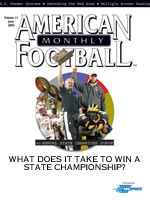AMERICAN FOOTBALL MONTHLY THE #1 RESOURCE FOR FOOTBALL COACHES
Article CategoriesAFM Magazine
|
Feeder FrenzyHigh Schools are beginning to connect with their middle and intermediate schools to help build their future by using the Feeder Systemby: Richard Scott © More from this issue No one would have predicted it. No one in Elizabethtown, Ky., in 1998 and ‘99 would have looked at the seventh and eighth graders playing for T.K. Stone Middle School and guessed they would someday reach the 2003 state championship game as high school seniors. “I don’t remember their record but they were pretty much a .500 team in seventh and eighth grade,” former Elizabethtown High School coach Brett Burnett said. “But that was a group of kids that really bought into what we did, stuck with it and worked hard. We didn’t have a lot of outstanding athletes but we had a lot of blue-collar kids and they came up through the program and played for a state championship their senior year.” Today, Burnett is preparing for his first season at Pelham High ....The full article can only be seen by subscribers. Subscribe today!
|
|
|||||||
| HOME |
MAGAZINE |
SUBSCRIBE | ONLINE COLUMNISTS | COACHING VIDEOS |
Copyright 2025, AmericanFootballMonthly.com
All Rights Reserved





